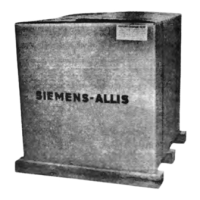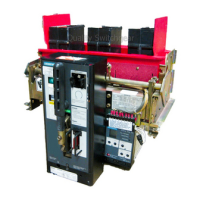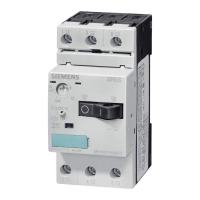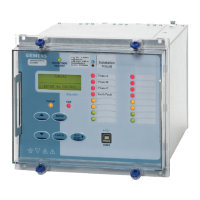1
i
i
'
l
elNSTALLATION
•
•
INSTALLATION SEQUENCE
:;:;q~4.;::
:=:::-:;;._:-a::·;;>::-;
fl:
il;';.dJJ.ltf.Qfi\
Be certain that you check points
1a
through
11
below
before placing
circuit
breaker in compartment.
1. Determine the correct switchgear compartment for
each
circuit
breaker
by
checking
the
Three-Line Dia-
gram furnished with the drawings. The Three-Line
Diagram shows the following for
each
circuit breaker
compartment:
a.
Circuit
breaker Type (RL-800, RL-1600 etc.)
b.
Trip
"XFMR"
or
"SENSOR" rating.
c. Static
Trip
Type TS, TIG, TSG, etc.
d. Type
of
operator
(Manual
Operator-M.0.
or
Elec-
trical Operator-E.0.)
e.
Circuit
Breaker Wiring Diagram Numbers
f.
Special Accessories (Undervoltage Trip, etc.)
2.
On fused breaker make sure
trigger
fuse linkage is
reset. Breaker will remain trip free as long as this
linkage is tripped.
3.
After the
circuit
breaker
is
placed in the compartment,
rack
it
to the TEST position.
4.
Close and
trip
the
circuit
breaker. Refer to OPERAT-
ING PROCEDURE, pages 4 and 5
for
manually
and
electrically operated
circuit
breakers.
A
DANGER
~
HAZARDOUS
VOLTAGE
Do not work on energized equipment.
To
do
so
may result
in
property damage, serious personal
injury
or
death.
During
the closing operation, observe
that
the
con-
tacts move freely without interference
or
rubbing
between movable arcing contacts and parts of the arc
chutes. Then refer
to
OPERATION, pages 4 and 51or a
detailed description
of
the circuit breaker operating
characteristics before placing the circuit breaker in
service.
Make
sure circuits are not energized.
Page3
5. Trip units
and
accessory devices should receive a
thorough
check
before placing the
circuit
breaker
in
service. This
check
makes certain
that
adjustments
are proper and parts are
not
damaged. Refer
to
Static
Trip II Instruction Book SG-3098.
6.
Circuit
breakers are
equipped
with
a
draw-out
inter-
lock
to
prevent movement
of
a closed
circuit
breaker
into
or
out
of
the
connected
position.
Circuit
breaker
interlock
operation
should be checked
before
it
is
energized. See DRAW-OUT INTERLOCK, page
5,
and
SPRING DISCHARGE INTERLOCK, page
8,
for
a
description
of
these interlocks.
7.
After
completing
the
installation inspection, check
the
control
wiring
(if any) and test the insulation.
8.
Now
the
circuit
breaker is ready
to
be racked
into
the
CONNECTED position. Refer
to
RACKING
MECHA-
NISM, pages 7 and
8.
9.
The
circuit
breaker can
now
be
closed
to
energize the
circuit.
CAUTIONS
TO BE OBSERVED IN
INSTALLATION
AND
OPERATION
1.
Read this
Instruction
Book before installing
or
making
any
changes
or
adjustments on
the
circuit
breaker.
2.
Stored-energy
closing
springs may be charged
with
circuit
breaker contacts in either the open
or
closed
position. Extreme care
should
be taken
to
discharge
the springs before working on
the
circuit
breaker.
3.
When closing manually operated breakers
out
of
the
unit. the
racking
mechanism must be returned
to
the
test position before the closing spring can be charged.
4.
When charging manually operated breakers, always
hold
the handle
firmly
until
it
is returned
to
the
normal
vertical position. A ratchet insures
that
the
closing
stroke must be completed
once
started.
5.
Check current ratings,
circuit
breaker
wiring
diagram
numbers,
circuit
breaker type and static
trip
type,
against the
Three-Line
Diagram
to
assure
that
circuit
breakers are located in the
proper
compartments
within the switchgear.
6.
Check the
alignment
of
the
secondary
disconnect
fin-
gers. This ensures against misalignment
due
to
possi-
ble distortion of
lingers
during shipment and handling.
7.
Close the compartment
door
and secure
door
latch(es)
prior to racking the circuit
breaker
to
or
from
the
Courtesy of NationalSwitchgear.com

